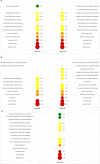Influence of the Social Environment on Ideal Cardiovascular Health
- PMID: 36789849
- PMCID: PMC10111502
- DOI: 10.1161/JAHA.122.026790
Influence of the Social Environment on Ideal Cardiovascular Health
Abstract
Background The environment plays a large role in the health of individuals; however, more research is needed to better understand aspects of the environment that most influence health. Specifically, our study examines how the social environment influences cardiovascular health (CVH). Methods and Results The social environment was characterized using measures of belonging and life and work stress in individuals, as well as nationally derived measures of marginalization, deprivation, economic status, and community well-being in neighborhoods. CVH was defined by the American Heart Association's Cardiovascular Health Index-a summed score of 7 clinical and behavioral components known to have the greatest impact on CVH. Data were obtained from the Canadian Community Health Survey 2015 to 2016 and multiple national data sources. Multilevel regression models were used to analyze the associations between CVH and the social environment. Overall, 27% of Canadians reported ideal CVH (6-7 score points), 68% reported intermediate CVH (3-5 score points), and 5% reported poor CVH (0-2 score points). The neighborhood environment contributed up to 7% of the differences in CVH between individuals. Findings indicated that residing in a neighborhood with greater community well-being (odds ratio [OR], 1.33 [95% CI, 1.26-1.41]) was associated with achieving higher odds of ideal CVH, while weaker community belonging (OR, 0.67 [95% CI, 0.62-0.72]) and residing in a neighborhood with greater marginalization (OR, 0.87 [95% CI, 0.82-0.91]) and deprivation (OR, 0.67 [95% CI, 0.64-0.69]) were associated with achieving lower odds of ideal CVH. Conclusions Aspects of individual-level social environment and residing in a neighborhood with a more favorable social environment were both independently and significantly associated with achieving ideal CVH.
Keywords: cardiovascular health; determinants of health; multilevel modeling; population health; social environment.
Figures


Similar articles
-
Neighborhood characteristics and ideal cardiovascular health among Black adults: results from the Morehouse-Emory Cardiovascular (MECA) Center for Health Equity.Ann Epidemiol. 2022 Jan;65:120.e1-120.e10. doi: 10.1016/j.annepidem.2020.11.009. Epub 2020 Dec 5. Ann Epidemiol. 2022. PMID: 33285258 Free PMC article.
-
Association of neighborhood characteristics with cardiovascular health in the multi-ethnic study of atherosclerosis.Circ Cardiovasc Qual Outcomes. 2014 Jul;7(4):524-31. doi: 10.1161/CIRCOUTCOMES.113.000698. Circ Cardiovasc Qual Outcomes. 2014. PMID: 25006187 Free PMC article.
-
Differences in Cardiovascular Health Metrics in Emergency Medical Technicians Compared to Paramedics: A Cross-Sectional Study of Emergency Medical Services Professionals.Prehosp Disaster Med. 2019 Jun;34(3):288-296. doi: 10.1017/S1049023X19004254. Epub 2019 Apr 29. Prehosp Disaster Med. 2019. PMID: 31030709
-
Life Course Cardiovascular Health: Risk Factors, Outcomes, and Interventions.Circ Res. 2023 Jun 9;132(12):1570-1583. doi: 10.1161/CIRCRESAHA.123.321998. Epub 2023 Jun 8. Circ Res. 2023. PMID: 37289908 Review.
-
Further understanding of ideal cardiovascular health score metrics and cardiovascular disease.Expert Rev Cardiovasc Ther. 2021 Jul;19(7):607-617. doi: 10.1080/14779072.2021.1937127. Epub 2021 Jun 15. Expert Rev Cardiovasc Ther. 2021. PMID: 34053373 Free PMC article. Review.
Cited by
-
Associations of neighborhood sociodemographic environment with mortality and circulating metabolites among low-income black and white adults living in the southeastern United States.BMC Med. 2024 Jun 18;22(1):249. doi: 10.1186/s12916-024-03452-6. BMC Med. 2024. PMID: 38886716 Free PMC article.
-
Socioeconomic status as a potential mediator of arterial aging in marginalized ethnic and racial groups: current understandings and future directions.J Appl Physiol (1985). 2024 Jul 1;137(1):194-222. doi: 10.1152/japplphysiol.00188.2024. Epub 2024 May 30. J Appl Physiol (1985). 2024. PMID: 38813611 Free PMC article. Review.
-
Cardiovascular health metrics and all-cause mortality in osteoarthritis, inflammatory arthritis, and unclassified arthritis patients: a national prospective cohort study.Arthritis Res Ther. 2024 Oct 16;26(1):179. doi: 10.1186/s13075-024-03410-w. Arthritis Res Ther. 2024. PMID: 39415270 Free PMC article.
-
The Role of Psychological Health in Cardiovascular Health: A Racial Comparison.Healthcare (Basel). 2025 Apr 8;13(8):846. doi: 10.3390/healthcare13080846. Healthcare (Basel). 2025. PMID: 40281794 Free PMC article.
-
Food Insecurity and Its Cardiovascular Implications in Underresourced Communities.J Am Heart Assoc. 2025 Mar 18;14(6):e037457. doi: 10.1161/JAHA.124.037457. Epub 2025 Mar 13. J Am Heart Assoc. 2025. PMID: 40082777 Free PMC article. Clinical Trial.
References
-
- Murray CJ, Aravkin AY, Zheng P, Abbafati C, Abbas KM, Abbasi‐Kangevari M, Abd‐Allah F, Abdelalim A, Abdollahi M, Abdollahpour I. Global burden of 87 risk factors in 204 countries and territories, 1990–2019: a systematic analysis for the global burden of disease study 2019. Lancet. 2020;396:1223–1249. doi: 10.1016/S0140-6736(20)30752-2 - DOI - PMC - PubMed
-
- Zoghbi WA, Duncan T, Antman E, Barbosa M, Champagne B, Chen D, Gamra H, Harold JG, Josephson S, Komajda M, et al. Sustainable development goals and the future of cardiovascular health. A statement from the global cardiovascular disease taskforce. Eur Heart J. 2014;35:3238–3239. - PubMed
-
- Younus A, Aneni EC, Spatz ES, Osondu CU, Roberson L, Ogunmoroti O, Malik R, Ali SS, Aziz M, Feldman T, et al. A systematic review of the prevalence and outcomes of ideal cardiovascular health in US and non‐US populations. Mayo Clin Proc. 2016;91:649–670. doi: 10.1016/j.mayocp.2016.01.019 - DOI - PubMed
-
- Ramírez‐Vélez R, Saavedra JM, Lobelo F, Celis‐Morales CA, del Pozo‐Cruz B, García‐Hermoso A. Ideal cardiovascular health and incident cardiovascular disease among adults: a systematic review and meta‐analysis. Paper/Poster presented at: Mayo Clinic Proceedings. 2018. - PubMed
Publication types
MeSH terms
LinkOut - more resources
Full Text Sources

